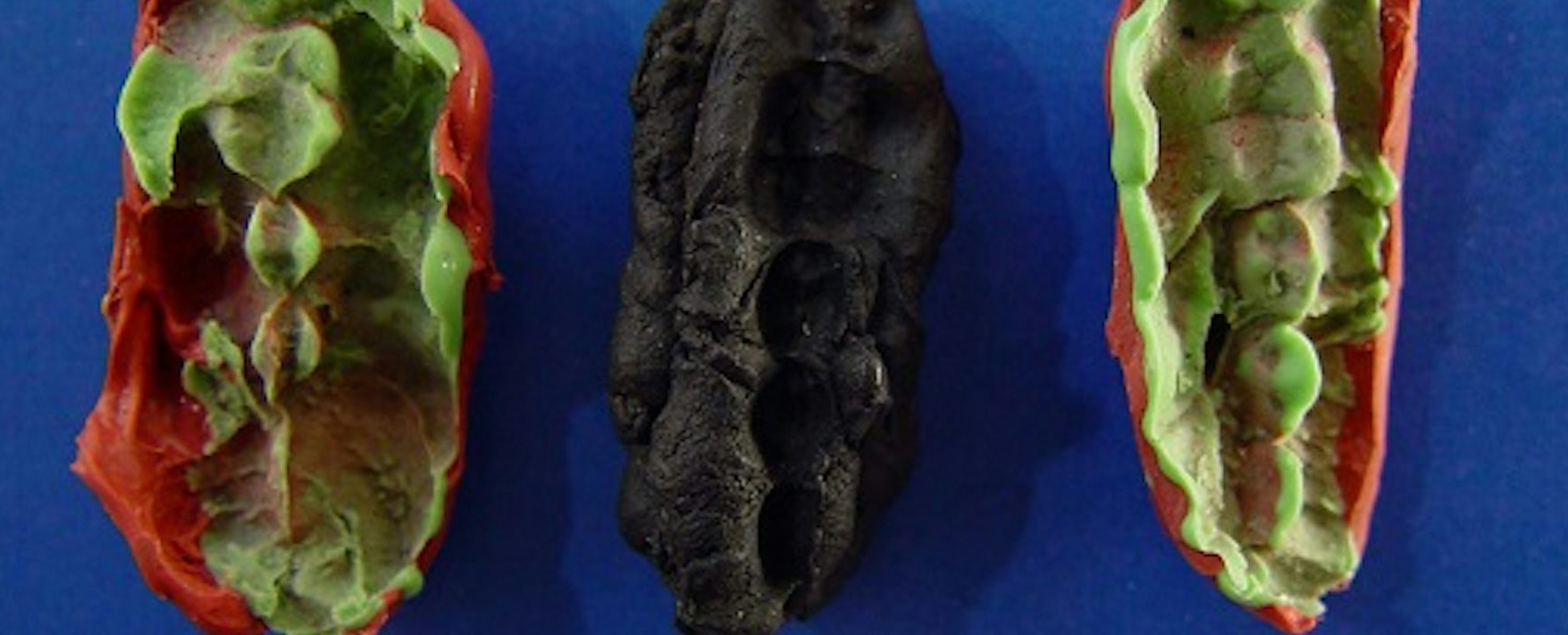Some 9,700 years ago on an autumn day, a group of people were camping on the west coast of Scandinavia. They were hunter-gatherers that had been fishing, hunting and collecting resources in the area.
Some teenagers, both boys and girls, were chewing resin to produce glue, just after eating trout, deer and hazelnuts. Due to a severe gum infection (periodontitis), one of the teenagers had problems eating the chewy deer-meat, as well as preparing the resin by chewing it.
This snapshot of the Mesolithic period, just before Europeans started farming, comes from analysis of DNA left in the chewed resin that we have conducted, now published in Scientific Reports.
The location is now known as Huseby Klev, situated north of Gothenburg (Göteborg), Sweden. It was excavated by archaeologists in the early 1990s, and yielded some 1,849 flint artefacts and 115 pieces of resin (mastic).
The site has been radiocarbon dated to between 10,200 and 9,400 years ago, with one of the pieces of resin dated to 9,700 years ago.
Some of the resin has teeth imprints, indicating that children, actually teenagers, had been chewing them. Masticated lumps, often with imprints of teeth, fingerprints or both, are not uncommon to find in Mesolithic sites.
The pieces of resin we have analysed were made of birch bark pitch, which is known to have been used as an adhesive substance in stone tool technology from the Middle Palaeolithic onward. However, they were also chewed for recreational or medicinal purposes in traditional societies.
A variety of substances with similar properties, such as resins from coniferous trees, natural bitumen, and other plant gums, are known to have been used in analogous ways in many parts of the world.
The power of DNA
In some of the resin, half the DNA extracted was of human origin. This is a lot compared to what we often find in ancient bones and teeth.
It represents some of the oldest human genomes from Scandinavia. It has a particular ancestry profile common among Mesolithic hunter gatherers who once lived there.
Some of the resin contains male human DNA while others have female DNA. We think that teenagers of both sexes were preparing glue for use in tool making, such as attaching a stone axe to a wooden handle.
But what of the other half of the DNA that was of non-human origin? Most of this DNA is from organisms such as bacteria and fungi that have lived in the mastic since it was discarded 9,700 years ago. But some of it was from bacteria living in the human that chewed it, along with material the human had been chewing on before they put the birch bark pitch in their mouths.
Analysing all this DNA is a demanding task and treads new ground. We had to both adapt existing computing tools and also develop some new analytical strategies. As such, this work has become the starting point for developing a new workflow for this kind of analysis.
This includes mining the DNA using different strategies to characterise it, trying to piece together short DNA fragments into longer ones and using machine learning techniques to work out which DNA fragments belong to pathogens (harmful microorganisms). It also involves comparing the data to what we see in the mouths of modern people with tooth decay (caries) and periodontitis.
Higher organisms
Naturally, we found the kind of bacteria that would be expected in an oral microbiome, the range of naturally occurring microorganisms found in the mouth. We also found traces of bacteria implicated in conditions such as tooth decay or caries (Streptococcus mutans), and systemic diseases such as Hib disease and endocarditis. There were also bacteria that can cause abscesses.
Although these pathogenic microorganisms were present at an elevated frequency, they were not clearly above the level expected for a healthy oral microbiome. There is thus no conclusive evidence that members of the group suffered from diseases these microorganisms are associated with.
What we did find, however, was an abundance of bacteria associated with serious gum disease – periodontitis. When we applied a machine learning strategy (in this case, a technique called Random Forest modelling) we reached the conclusion that the girl who chewed one of the pieces of resin had probably suffered from periodontitis – with more than a 75% probability.
We also found DNA from larger organisms than just bacteria. We found DNA for red deer, brown trout and hazelnuts. This DNA probably came from material the teenagers had been chewing before they put the birch pitch in their mouths.
However, we need to be a little bit cautious because exactly what we find is also dependent on the comparison data that we have. As genomes from eukaryotic organisms – the group that includes plants and animals – are larger and more complex than those from microorganisms, it is more complicated to assemble a eukaryotic genome of high quality.
There are fewer eukaryotic genomes in the samples of resin, and they are of lower quality. This means that our brown trout, for example, may not actually be a brown trout, but we at least feel certain it is from the salmon family.
We also found a lot of fox DNA, but this is harder to interpret. Fox meat may have been a part of the diet, but these teenagers could also have chewed on tendons and fur from foxes for use in textiles. Alternatively, the fox DNA could even be from territorial marking and got into the resin after it was spat out.
However, what we have learned for sure represents a big step in understanding these fascinating records of human culture from the Stone Age. As we analyse more of these, even more surprises could emerge.
Anders Götherström, Professor in Molecular Archaeology, Department of Archaeology and Classical Studies, Stockholm University and Emrah Kırdök, Assistant Professor, Department of Biotechnology, Mersin University
This article is republished from The Conversation under a Creative Commons license. Read the original article.





